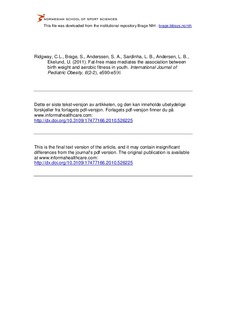Fat-free mass mediates the association between birth weight and aerobic fitness in youth
| dc.contributor.author | Ridgway, C. L. | |
| dc.contributor.author | Brage, Søren | |
| dc.contributor.author | Anderssen, Sigmund A. | |
| dc.contributor.author | Sardinha, Luis B. | |
| dc.contributor.author | Andersen, Lars Bo | |
| dc.contributor.author | Ekelund, Ulf | |
| dc.date.accessioned | 2011-12-07T08:56:42Z | |
| dc.date.available | 2011-12-07T08:56:42Z | |
| dc.date.issued | 2011-06 | |
| dc.identifier | Seksjon for idrettsmedisinske fag / Department of Sports Medicine | |
| dc.identifier.citation | International Journal of Pediatric Obesity. 2011, 6(2-2), e590-e596 | no_NO |
| dc.identifier.issn | 1747-7174 | |
| dc.identifier.issn | 1747-7166 | |
| dc.identifier.uri | http://hdl.handle.net/11250/170897 | |
| dc.description | I Brage finner du siste tekst-versjon av artikkelen, og den kan inneholde ubetydelige forskjeller fra forlagets pdf-versjon. Forlagets pdf-versjon finner du på www.informahealthcare.com: http://dx.doi.org/10.3109/17477166.2010.526225 / In Brage you'll find the final text version of the article, and it may contain insignificant differences from the journal's pdf version. The original publication is available at www.informahealthcare.com: http://dx.doi.org/10.3109/17477166.2010.526225 | no_NO |
| dc.description.abstract | Objective: To investigate whether birth weight acts as a biological determinant of later aerobic fitness, and whether fat free mass may mediate this association. Methods: The European Youth Heart Study (EYHS) is a population based cohort of two age groups (10 and 15 years) from Denmark, Portugal, Estonia and Norway. Children with parentally reported birth weight >1.5kg were included (n=2,749). Data was collected on weight, height, and skin fold measures to estimate fat mass and fat free mass. Aerobic fitness (peak power, watts) was assessed using a maximal, progressive cycle ergometer test. Physical activity was collected in a subset (n=1,505) using a hipworn accelerometer and defined as total activity counts/wear time, all children with >600 minutes/day for 3 days of wear were included. Results: Lower birth weight was associated with lower aerobic fitness, after adjusting for sex, age group, country, sexual maturity and socio-economic status (ß=5.4, 95%CI 3.5, 7.3 W per 1kg increase in birth weight, p<0.001). When fat free mass was introduced as a covariate in the model, the association between birth weight and aerobic fitness was almost completely attenuated (p=0.7). Birth weight was also significantly associated with fat free mass (ß=1.4 95%CI 1.1, 1.8, p<0.001) and fat free mass was significantly associated with aerobic fitness (ß=3.6, 95%CI 3.4, 3.7, p<0.001). Further adjustment for physical activity did not alter the findings. Conclusion: Birth weight may have long-term influences on fat free mass and differences in fat free mass mediate the observed association between birth weight and aerobic fitness. | no_NO |
| dc.language.iso | eng | no_NO |
| dc.publisher | Taylor & Francis | no_NO |
| dc.subject | birth weight | no_NO |
| dc.subject | aerobic fitness | no_NO |
| dc.subject | body composition | no_NO |
| dc.subject | fat-free mass | no_NO |
| dc.subject | youth | no_NO |
| dc.title | Fat-free mass mediates the association between birth weight and aerobic fitness in youth | no_NO |
| dc.type | Journal article | no_NO |
| dc.type | Peer reviewed | no_NO |
| dc.subject.nsi | VDP::Medical disciplines: 700::Clinical medical disciplines: 750::Pediatrics: 760 | no_NO |
| dc.source.pagenumber | e590-e596 | no_NO |
| dc.source.volume | 6 | no_NO |
| dc.source.journal | International Journal of Pediatric Obesity | no_NO |
| dc.source.issue | 2-2 | no_NO |
Tilhørende fil(er)
Denne innførselen finnes i følgende samling(er)
-
Artikler / Articles [2119]
